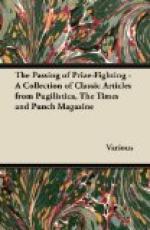And therefore he is a Conservative Reformer—
Wherefore, having three sides, which are all the same to him—viz. Reform, Conservatism, and himself—he is an independent member, and has been described as a Conservative Reformer.
Quod erat double-face-iendum.
PROP. II.—PROBLEM.
From a given point to draw out a Radical Member to a given length.
Let A or his ancestors be the given point, and an A s s the given length; it is required to draw out upon the point of his ancestors a Radical member equal to an A s s.
[Illustration]
Connect the A s s with A, his ancestors.
On the A s s and A his ancestors, describe an independent
member S R I,
Sir Robert Inglis.
Then with S R I, Sir Robert Inglis, draw out the A s s to G L and S A, or great literary and scientific attainments.
And with S R I, Sir Robert Inglis, let R Roebuck,
be got into a line upon
A, his ancestors.
With the A s s in the middle, describe the circulation of T N, or “Times” newspaper.
And with SRI, Sir Robert Inglis, as the centre, describe
the Circle of the
H of C, or House of Commons.
Then R A, or Roebuck on his ancestors, equals an A s s.
For because the A s s was in the middle of T N, or “Times” newspaper.
Therefore the rhodomontade of G L and S A, or great literary and scientific attainments, was equal to the braying of an A s s.
And because S R I, or Sir Robert Inglis, was in the
centre of H C, or
House of Commons.
Therefore S R I on G L and S A, or Sir Robert Inglis on the great literary and scientific attainments, was only to be equalled by S R I and R, or Sir Robert Inglis and Roebuck.
But Sir R I is always equal to himself.
Therefore the remainder, A R, or Roebuck on his ancestors, is equal to the remaining G L and S A, or great literary and scientific attainments.
But G L and S A, or the great literary and scientific attainments, have been shown to be equal to those of an A s s.
And therefore R A, or Roebuck on his ancestors, is equal to an A s s.
Wherefore, from a given point, A, his ancestors, has been drawn out a Radical member, R, Roebuck, equal to an A s s.
Quod erat sheep-face-iendum.
PROP. III.—PROBLEM
From the greater opposition
of two members to a given measure to
cut, off a part, so as it
may agree with the less.
Let P C and W R, or Peel the Conservative and Wakley the Radical, represent their different oppositions to the New Poor Law, to which that of W R, or Wakley the Radical, is greater than that of Peel the Conservative—it is required to cut off from W R, or Wakley the Radical’s opposition a part, so that it may agree with that of P C, or Peel the Conservative.




